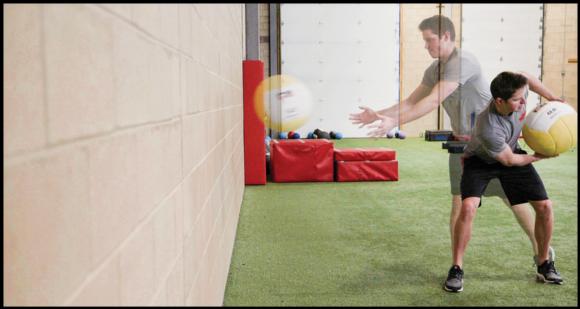Written in conjunction with Strength Coach Podcast Ep. 308
In our last episode of Learn To Coach, Brendon Rearick discussed how to put together an assessment workout so you can introduce a new client to training to determine which exercises to choose when building a program. In this week’s episode we’re going to follow that up by talking about program design and how you can go about structuring a basic training program for your group and personal training clients.
A well-balanced program should address mobility, warm-ups, power development, strength and conditioning and should be programmed and implemented in the following order to ensure an optimal training outcome:
All programs should begin with foam rolling and active mobility drills to reduce tissue tone and improve tissue extensibility prior to higher intensity activity. Clients should go through a full body foam roll in about 5 minutes followed by 5-10 minutes of active stretching drills that focus on improving and priming mobility in the hips, thoracic spine, shoulders and ankles.
After the mobility portion of the we should next move to the movement preparation and warm-up section of the workout. Overall this entire section should only take about 10 minutes but it is an important step to prepare the body for the rigors of the upcoming training session. In this sections we should begin with static movements like bodyweight split squats and and single leg deadlifts for active stretching and progress towards dynamic athletic movements like skipping, shuffling and back pedaling to develop movement skills, increase body temperature and prime the central nervous systems for the high intensity training that is about to come.
Next, we should progress to light implement power drills like jumps, hops and bounds and medicine ball throws. These drills should be incorporated both for athletes and general population clients albeit at different intensities to accommodate the clients readiness, skill level and injury history. The ability to rapidly produce and absorb force is beneficial for both competitive athletes as well as the adult clientele to maintain functionality with age.


It is important to place high-speed, neurologically demanding movements like hopping, jumping, and throwing early in the program, before strength training, so you will not be performing them while you are fatigued.
After completing plyometric and medicine ball drills, you should head to the weight room to begin heavy implement power and strength training exercises. The guiding principle is similar to that for programming plyometric and medicine ball drills; you should program heavy implement power drills, like hang cleans and kettlebell swings, before heavy strength training exercises because of the high neurological load they place on your nervous system. To ensure you can perform these exercises at high speed and are not excessively fatigued, cleans, swings, and loaded jumps should be performed before slow heavily loaded exercises such as squats and deadlifts.
After our heavy implement power drills we should progress into the strength training portion of the training program. It is important to distribute all of the different strength movement patterns evenly throughout the workout program. Ideally, each day should include an exercise from each category: knee dominant, hip dominant, push, pull, and core. Distributing exercise selection in this fashion will ensure you are developing your entire body evenly.
In the interest of saving time and being efficient, you should look to program all of these exercises in pairs or tri-sets, pairing or grouping two or three exercises together and performing them back-to-back in an alternating fashion. It is important to pair or group exercises that are noncompeting, meaning that they are not targeting the same patterns and muscle groups. Creating pairs and tri-sets of noncompeting exercises allows you to be more efficient in that you are training one exercise while simultaneously recovering from another. Typically, we will include 2 to 3 tri sets in the weightroom over the course of an entire workout.
Finally, we want to move to the last portion of the workout, conditioning. Utilizing high intensity interval training with modes like running, the assault bike and slideboarding we can work on improving the clients aerobic and anaerobic energy production while also being efficient with our time.Typically, the conditioning section of the program will only take about 10-15 minutes at the end of the training program and we will vary which mode of exercise we use throughout the week.

Ultimately, the program should take about 60-minutes so you are efficient with your time and so that it can fit into a commercially friendly model. All clients, both athletes and general population should take part in all sections of the program. A complete functional performance program should not just focus on the development of one single component but should strive to develop movement quality, strength, power, and cardiovascular fitness concurrently. The variable demands of most sporting environments and the interconnected nature of the human body require more than the expression of a singular capacity if one hopes to achieve success and longevity in sports and life. As we always say, training is a recipe not a menu. You can’t just pick the things you like, you need to account for all the ingredients in a program for a successful outcome.
ARE YOU CERTIFIED YET?
Our Certified Functional Strength Coach Level 1 Online Course is designed to provide you with the same experience you’d get attending our live Level 1 workshop. Complete with the same pre-workshop materials, our Online Course includes a ‘Virtual Live Workshop’, where you will follow a CFSC instructor through an entire Level 1 Workshop complete with instruction, demonstration and question and answer as if you were spending the day at Mike Boyle Strength and Conditioning. Keeping with our rigorous practical standards, all enrollees will be required to complete an online exam and a coaching practical featuring video and open ended questions to complete their certification.